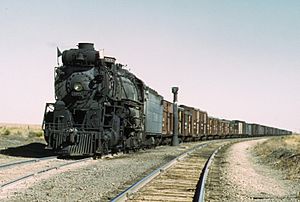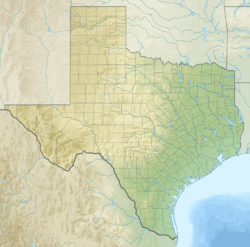Santa Fe 5000 facts for kids
Quick facts for kids Santa Fe 5000 |
|
 |
|
| Atchison, Topeka & Santa Fe Railway 2-10-4 steam locomotive No. 5000 "Madame Queen" waiting in a siding to meet an eastbound train in Ricardo, New Mexico, March 1943 | |
| Power type | Steam |
|---|---|
| Builder | Baldwin Locomotive Works |
| Serial number | 61524 |
| Build date | 1930 |
| Configuration | 2-10-4 |
| Gauge | 4 ft 8 1⁄2 in (1,435 mm) |
| Driver diameter | 69 in (1,800 mm) |
| Wheelbase | 24 ft 6 in (7.47 m) (driving wheelbase) |
| Boiler | 108 in (2,700 mm) diameter |
| Fire grate area | 121.7 sq ft (11.31 m2) |
| Cylinder size | 30 in (760 mm) diameter x 34 in (860 mm) stroke |
| Tractive effort | 95,584 lbf (425.18 kN) |
| Factor of adhesion | 3.89 |
| Retired | April 17, 1957 |
| Current owner | The City of Amarillo, Texas |
| Disposition | On static display in Amarillo, Texas |
|
Atchison, Topeka and Santa Fe Railway Company Depot and Locomotive No. 5000
|
|
| Location | 307 S. Grant, Amarillo, Texas |
| Area | 12 acres (4.9 ha) |
| Architect | E.A. Harrison |
| Architectural style | Mission/Spanish Revival, 5000 Series Steam Locomotive |
| NRHP reference No. | 86002189 |
| Added to NRHP | September 18, 1986 |
Santa Fe 5000 is a 2-10-4 "Texas" type steam locomotive constructed by Baldwin Locomotive Works in 1930 for the Atchison, Topeka and Santa Fe Railway. No. 5000 was immediately nicknamed the "Madame Queen" and remained a unique member of its own class. It was donated to the City of Amarillo, Texas, in 1957 and is currently maintained by the Railroad Artifact Preservation Society. Santa Fe 5000 is on the National Register of Historic Places.
Construction
The Texas type on the Santa Fe is by design a Berkshire with an additional driving axle, as it was ordered by most railroads. Although Santa Fe 3829 was the first steam locomotive with the 2-10-4 wheel arrangement, Santa Fe 5000 served as the prototype for all further 2-10-4 locomotives rostered by the road.
In 1930, Santa Fe looked at the contemporary heavy-duty motive power policies of other railroads, and decided that its own needed substantial reappraisal. Additional locomotives were ordered as a result of this study, including the 5000. Santa Fe 5000 was placed in service between Clovis and Vaughn, New Mexico for observation. The result was the company had purchased a locomotive which would pull 15% more tonnage in 9% less time, burning 17% less coal per 1000 gross ton miles than its 3800 series 2-10-2s.
Although the locomotive was a success, the 1930s brought the national depression and Santa Fe adopted a policy of avoiding capital expenditures during this period. By the time the next 2-10-4s were delivered in 1938 they were placed in a different class because of many design refinements. With the various classes of 4-8-4 types, the 2-10-4 type represented the pinnacle of modern heavy-power development on the Santa Fe Railway System.
Modifications
Santa Fe 5000 underwent few modifications during its service life. It received a larger 'square tender' which required the cab roof to be modified with an area that allowed crew members to pass from the cab to the top of the tender. In 1940 the locomotive was converted from coal to oil fuel.
Preservation
On April 17, 1957, after several years of storage and 1,750,000 miles (2,820,000 km) of service, Santa Fe 5000 was retired and donated to the city of Amarillo, Texas. It was placed on outdoor static display at the Santa Fe station. In August 2005, 5000 was moved by the Railroad Artifact Preservation Society to a new location in Amarillo, 500 SE 2nd Avenue, where they plan to construct a building to house and preserve the locomotive. In July 2016, the city of Amarillo proposed selling the locomotive.








